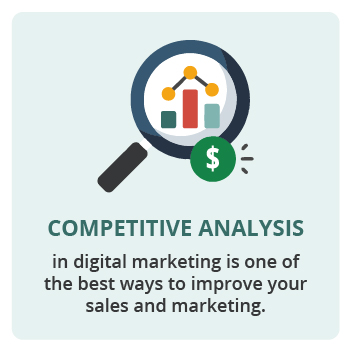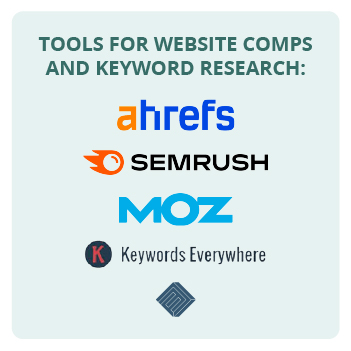Performing a competitive landscape analysis is one of the first steps in producing an effective digital strategy. Still, if you’re new to content audits or have never done a competitive analysis in digital marketing, it’s reasonable if you don’t know where to start.
First, competitor research, or competitive analysis, is precisely what it sounds like—you’re comparing your digital marketing and sales efforts to your competition through a complete teardown. If you decide you don’t want to do this yourself, we’re here to help.
Competitive analysis in digital marketing is one of the best ways to improve your sales and marketing. And while that claim sounds bold, let’s start with the benefits of competitor research as our first tip.
1. Understand the Advantages of Competitive Analysis in Digital Marketing

We want to acknowledge the work that goes into a complete competitor teardown may feel daunting, given how time-intensive and nuanced it is, but we promise it’s worth it.
The goal is to identify strengths and weaknesses to create a strategy that leverages what you learn from others to make data-driven content improvements. Every website needs one to stay innovative and to reach new customers.
The Benefits of Competitive Analysis in Digital Marketing
- Improved understanding of your market
- Exposes strengths and weaknesses between you and your competitors
- Provides a competitive edge against rival businesses
- Enhances your knowledge of your audience and the buyer’s journey
- Surfaces market gaps and opportunities
- Sweetens your sales and marketing efforts
2. Find the Right Competitors
For many, knowing where to start is the most challenging part of a digital marketing competitive analysis. Unfortunately, some make the mistake of comparing a smaller brand with giants like Patagonia or others.
Remember, a content audit or assessing the competitive landscape aims to find organizations comparable with yours. While you can use more prominent brands for inspiration, starting with 3-5 equal-sized businesses or those slightly above or below in sales or audience size is best.
So, how do you know who to pick? Answer some or all of the following questions to find comparable brands.
- Is this brand in my industry?
- Do they sell similar products or services?
- Does this brand overlap with my audience?
- How do they compare to the size of my business?
- Are they using similar sales channels?
- Is this business a direct competitor?
Keep in mind that those are just a few questions we ask ourselves when executing a digital marketing competitor analysis before kicking off our strategies. Regardless, answering those questions usually sets a solid foundation for understanding which businesses to target.
3. Cozy Up to the Competition
There isn’t an easy way to analyze the competitive landscape without putting in the work. For example, at our digital agency in Portland, we evaluate our clients’ top competitors and leverage findings to provide the best results.
And while this is time-consuming and requires specific skills, this research allows us to deliver a complete competitive analysis that provides a thorough understanding of competitors and the customer journey.
Taking your time is essential to understanding the landscape. So take notes—lots of notes—of the pros and cons found during your digital marketing competitive analysis by evaluating the following areas:
Website: Consider usability, site makeup, content, tone of voice, site speed, and imagery when evaluating a rival site.
Social profiles: Explore your competitors’ social profiles to see what they’re doing well to surface areas of improvement. This includes all major social platforms like TikTok, YouTube, Twitter, Facebook, Instagram, etc.
Email marketing: Subscribe to competitor email newsletters to learn about promotional strategies, voice, and design—even if you’re not using this channel yet.
Audience: Consider audience overlap and understand where to meet new buyers in their journey.
SEO: Evaluate your competitors’ keyword choices and backlinks to identify gaps and opportunities.
4. Leverage Tools
 The right competitive research tools are crucial for gathering comprehensive data and insights about your competitors. It also allows you to make informed strategic decisions by taking much of the guesswork out of who to analyze and how other companies perform in comparison to your brand.
The right competitive research tools are crucial for gathering comprehensive data and insights about your competitors. It also allows you to make informed strategic decisions by taking much of the guesswork out of who to analyze and how other companies perform in comparison to your brand.
And while tech tools tend to be cost-prohibitive for some, the ones we use in our content strategies allow us to know what we need to do to stay ahead of the market. Let’s break those down by type.
Tools for Website Comps and Keyword Research:
- Ahrefs
- SEM Rush
- Moz
- Keywords Everywhere
- Our proprietary software (shhhhh…)
While we can’t spill all of our industry secrets, and there are certainly more tools than the ones we listed, Mad Fish Digital considers these essential to developing a robust marketing strategy.
5. Remember, You Don’t Have to Do it Alone
We’ll be blunt—competitive research in digital marketing isn’t easy. It’s a significant time investment and requires access to various tools. It also demands a particular skill set that requires talented researchers and a high understanding of data analysis.
Empowering businesses to gain invaluable insights and discover strategic advantages is at the heart of what we do. If you need additional help from an experienced Portland digital agency, we’re ready when you are.
Mad Fish Digital offers complete content marketing strategies and à la carte competitive audits individualized to any business. To start the conversation, simply share a few details about your needs by contacting us, and we’ll follow up ASAP.

